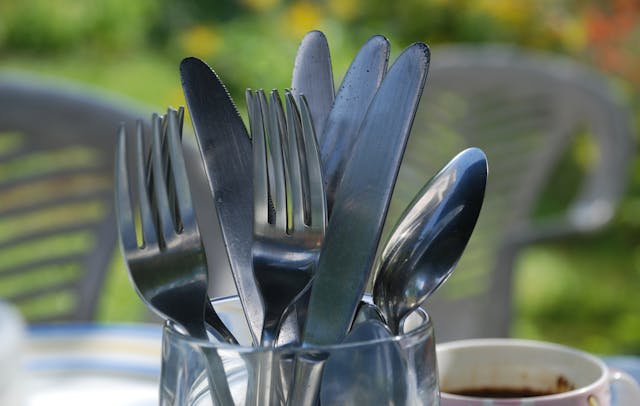
Why is stainless steel stainless? Stainless steel isn’t actually stainless, but a metal that is able to resist corrosion.
Stainless steel is a type of metal that is able to resist corrosion. A lot of metals corrode when they are exposed to oxygen. Oxygen is a very reactive molecule, which is one of the reasons why we need it to live. When metals are exposed to oxygen, they undergo a process called oxidization. Oxidization is the process whereby oxygen molecules strip away electrons from the surface of the metal. When this happens with iron, we end up with rust. Incidentally, oxidization is the name of the process and doesn’t have to involve oxygen, although it did when the process was discovered. When water gets in to the metal, it can make the oxidization worse and the metal can start to break down. This is why rust peels off from iron if it is left outside. Stainless steel is a metal that resists this corrosion and the oxidization.
So, why doesn’t stainless steel rust? Steel is a mixture of iron and carbon. It was a huge advance on iron because it is stronger and much less likely to fracture. It is used in many different places, but steel will rust. Stainless steel doesn’t rust because it has an extra ingredient in on top of the carbon and iron. That ingredient depends on the type of stainless steel, but one of the most common ones is chromium. Chromium is a metal that has many properties that make it just right for this use. It is very hard, it resists corrosion, and it polishes to a very high sheen. Chromium resists corrosion because it reacts with the oxygen in the air before the steel itself can do.
Steel has about 11% chromium in it. Chromium reacts to oxygen in the air in the same way that steel does, but the result is slightly different. Steel rusts and the oxygen can penetrate further and further into the metal. When chromium reacts with oxygen, it very quickly becomes chromium oxide and coats the steel. It is a very thin layer, but it stops the oxygen from getting through to the steel underneath. Another advantage of this is that if the stainless steel gets scratched or damaged, there is more chromium inside the metal that will come out and oxidize, repairing the damage and making it impervious again. It can heal itself.
That is not to say that stainless steel can’t corrode. All steels are graded and if stainless steel is exposed to conditions beyond its grading it can corrode. Strong acids can corrode it as well. Very salty conditions can cause it to corrode as well. When used on ships, even stainless steel will rust.
There is more than one type of stainless steel and each one is an alloy of different types of metals. The stainless steel I have been talking about, and the most common one you will find in your kitchen, is called ferritic steel, and it is made with iron, carbon, and 11% of chromium. It Is not magnetic and is easier to shape because it is softer. Then there is austenitic steel, which is made with nickel, molybdenum, iron, and carbon. It is a very heat resistant form of steel and is used in furnaces, boilers, engines, and other places that are very hot. Then there are martensitic steels, which have iron, carbon, and chromium, too, but they have more carbon than ferritic steels. They are very hard and durable. And last, there are duplex steels, which are a mix of austenite steel and ferrite steel.
Stainless steel was named by Ernest Stuart in about 1913, but he didn’t invent it. It was technically invented by Harry Brearley, but it was the work of a lot of scientists over about one hundred and fifty years that led to the discovery and the commercialization of stainless steel. Brearley wanted to call it Rustless Steel, but his friend, Ernest Stuart, thought Stainless Steel sounded better. Chromium was first discovered in 1798 and its resistance to oxidization was discovered in the early 1800s. An iron-chromium alloy was first made in 1821 by Pierre Berthier. He thought the metal might be good for cutlery. Chromium steel was produced for cannons in the 1850s and it was first patented in 1861. It was only in 1898 that it was realized the chromium was more efficient if there was less carbon in the alloy. Harry Brearley was continuing in all of this research while he was trying to make corrosion-resistant gun barrels just before World War 1 and he hit upon a way to industrialize martensitic stainless steel. It took off and from here on out it becomes far more commercial. And this is what I learned today.
Photo by Andrew Swarga: https://www.pexels.com/photo/stainless-steel-cutlery-12492018/
Sources
https://en.wikipedia.org/wiki/Steel
https://www.thoughtco.com/definition-of-oxidation-in-chemistry-605456
https://www.fictiv.com/articles/stainless-steel-why-do-we-call-it-stainless
https://home.howstuffworks.com/stainless-steel-impossible-stain-.htm
https://en.wikipedia.org/wiki/Chromium
https://en.wikipedia.org/wiki/Stainless_steel
